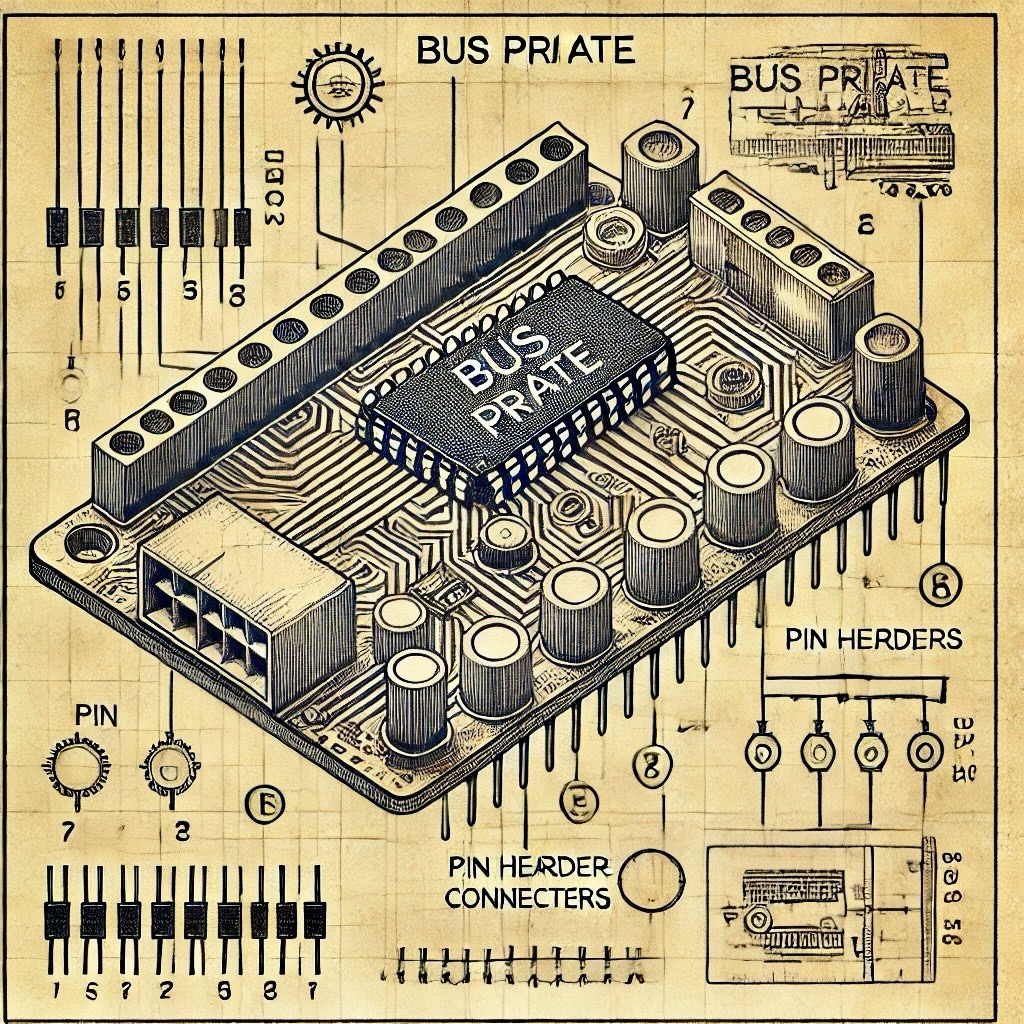Introduction
The Bus Pirate is a versatile tool designed for interfacing with a wide range of electronics and microcontroller devices. It supports various communication protocols, including UART, SPI, and I2C, making it ideal for debugging and prototyping embedded systems. Whether you're a hobbyist or a professional, the Bus Pirate helps streamline the development process with its simple and effective interface.
Key Features
The Bus Pirate offers a range of features that make it an essential tool for embedded systems development:
- Multi-Protocol Support: Supports UART, SPI, I2C, and other communication protocols, allowing easy interaction with a wide range of devices.
- Simple Command Interface: Uses a terminal interface with simple commands to configure the tool and interact with devices.
- Low-Cost Debugging: A cost-effective solution for debugging and testing embedded systems without requiring expensive hardware tools.
- Real-Time Data Interaction: Provides the ability to read and write data in real time, useful for testing and debugging communication with devices.
- Flexible Voltage Range: Can operate across a variety of voltage levels (2.8V to 5.0V), making it compatible with most microcontroller systems.
- Portable Design: Compact and lightweight, ideal for on-the-go development and debugging.
Applications
The Bus Pirate is widely used in a variety of applications:
- Embedded Development: Used by developers to interact with microcontroller devices and troubleshoot issues related to communication protocols.
- Prototyping and Testing: A key tool in prototyping, helping engineers test communication with sensors, devices, and peripherals during development.
- Educational Purposes: Ideal for students and educators to learn about microcontroller communication and debugging techniques.
- Hobbyist Projects: Popular among hobbyists who work on custom electronics and embedded systems projects.
Getting Started with Bus Pirate
Follow these basic steps to begin using the Bus Pirate:
- Connect the Bus Pirate to a Host Computer: Plug the Bus Pirate into your computer’s USB port and open a terminal program (e.g., PuTTY, Tera Term, or the Bus Pirate GUI).
- Set Baud Rate: Configure the baud rate and communication settings in the terminal to match the Bus Pirate’s configuration (usually 115200).
- Power the Target Device: Make sure your target device is powered and properly connected to the Bus Pirate.
- Select the Communication Protocol: Choose the appropriate communication mode (UART, SPI, or I2C) by typing the corresponding command in the terminal.
- Start Communication: Begin interacting with your target device using commands to send and receive data.
Example Use Case: Reading Data from a UART Device
Here's a quick example of how to use the Bus Pirate to read data from a UART device:
- Set the Bus Pirate to UART Mode: Type
mand select the UART option. - Configure UART Settings: Set the baud rate and other parameters (e.g., data bits, stop bits) using
U. - Connect the UART Device: Connect your UART device to the Bus Pirate.
- Start Reading Data: Type
rto begin reading data from the UART device.
Resources
- Bus Pirate Official Documentation - Detailed guide and user manual for the Bus Pirate tool.
- Bus Pirate Community Forum - Community discussions and troubleshooting tips for using the Bus Pirate.
- Bus Pirate Setup and Tutorial Video - Video tutorial for setting up and using the Bus Pirate.
Conclusion
The Bus Pirate is an indispensable tool for developers and hobbyists working with embedded systems. Its versatility, ease of use, and low cost make it a powerful option for debugging and interacting with microcontrollers and other electronic devices. Whether you're testing a new project or troubleshooting communication issues, the Bus Pirate simplifies the process, offering valuable insights into the functionality of your embedded systems.
100 Bus Pirate Experiments
- 1. SPI Communication with EEPROM
- 2. I2C Scanning and Device Communication
- 3. UART Serial Communication Debugging
- 4. Analyzing SPI Traffic from SD Card
- 5. Controlling a Stepper Motor using I2C
- 6. Flashing Microcontroller Firmware via SPI
- 7. Capturing and Decoding Infrared Signals
- 8. Interfacing with a 7-Segment Display using SPI
- 9. Sniffing I2C Traffic from an Accelerometer
- 10. Debugging UART on a GPS Module
- 11. Analyzing SMBus Communication with Laptop Battery
- 12. Interfacing with a Digital Potentiometer via SPI
- 13. Reading Data from a DS18B20 Temperature Sensor (1-Wire)
- 14. Generating PWM Signals to Control a Motor
- 15. Using the Bus Pirate as a Logic Analyzer
- 16. Sniffing CAN Bus Traffic from a Car ECU
- 17. Interfacing with OLED Displays using I2C
- 18. Testing and Debugging an LED Driver Circuit via SPI
- 19. Interfacing with a DAC via SPI to Generate Analog Signals
- 20. Monitoring Traffic on a Digital I2C Bus
- 21. Controlling a Relay via UART Commands
- 22. Sniffing USB Communication with the Bus Pirate USB Adapter
- 23. Reading Data from an IMU via I2C
- 24. Capturing Data from a RFID Reader
- 25. Flashing AVR Microcontrollers using the Bus Pirate
- 26. Sniffing JTAG Communication
- 27. Reading and Writing to an SD Card via SPI
- 28. Debugging an RF Transceiver via SPI
- 29. Capturing and Decoding 433MHz RF Signals
- 30. Programming an EEPROM using the Bus Pirate
- 31. Reverse Engineering I2C Communication from a Digital Scale
- 32. Analyzing I2S Audio Signals using the Bus Pirate
- 33. Controlling a Servo Motor via PWM
- 34. Sniffing SPI Traffic from a Flash Memory Chip
- 35. Debugging an I2C RTC Module
- 36. Capturing Data from a Keypad via UART
- 37. Flashing STM32 Microcontrollers using SWD
- 38. Generating and Capturing PWM Signals
- 39. Debugging a USB-to-Serial Adapter
- 40. Reading Data from a Rotary Encoder via I2C
- 41. Interfacing with a DHT22 Sensor using 1-Wire
- 42. Sniffing SPI Traffic on a Digital Thermometer
- 43. Capturing CAN Bus Messages from an OBD-II Interface
- 44. Reverse Engineering Wireless Remote Controls
- 45. Debugging a Wi-Fi Module via UART
- 46. Sniffing and Decoding DMX Lighting Signals
- 47. Interfacing with a Capacitive Touch Sensor via I2C
- 48. Monitoring UART Communication on a GSM Module
- 49. Reading Data from a Humidity Sensor via I2C
- 50. Flashing ESP8266 Modules via SPI
- 51. Debugging 1-Wire Communication on a Temperature Sensor
- 52. Sniffing SPI Traffic on a DAC Module
- 53. Analyzing Data from a Z-Wave Transceiver
- 54. Capturing UART Traffic from a Bluetooth Module
- 55. Interfacing with an RGB LED Driver via I2C
- 56. Debugging USB Communication with a USB Flash Drive
- 57. Capturing Data from a Game Controller via UART
- 58. Sniffing Data from a Digital Compass via I2C
- 59. Debugging an IR Receiver via UART
- 60. Programming a CPLD via JTAG
- 61. Interfacing with an LDR Sensor using ADC
- 62. Sniffing SPI Traffic on a Digital Oscilloscope
- 63. Monitoring UART Communication from a Smart Home Hub
- 64. Reading Data from a Distance Sensor via I2C
- 65. Debugging a Magnetic Sensor via SPI
- 66. Sniffing I2C Communication on an Electric Scooter Controller
- 67. Capturing 433MHz RF Signals using the Bus Pirate
- 68. Debugging UART Communication on a Zigbee Module
- 69. Programming a Flash Memory Chip via SPI
- 70. Reading Data from an Air Quality Sensor via I2C
- 71. Sniffing RS485 Traffic on a Solar Panel Inverter
- 72. Debugging a Proximity Sensor via I2C
- 73. Sniffing and Decoding SPI Data from a MicroSD Card
- 74. Monitoring UART Traffic from a Smart Light Bulb
- 75. Interfacing with a Pressure Sensor via I2C
- 76. Sniffing Traffic from a LoRa Module via UART
- 77. Debugging UART Communication on a GSM Shield
- 78. Capturing Traffic from a Bluetooth LE Device
- 79. Flashing a Microcontroller using the Bus Pirate SWD Interface
- 80. Monitoring UART Communication from an IoT Gateway
- 81. Debugging a Thermocouple Amplifier via SPI
- 82. Sniffing and Analyzing I2C Traffic from a Wearable Device
- 82. Sniffing and Analyzing I2C Traffic from a Wearable Device
- 83. Reading Data from a Force Sensor via I2C
- 84. Debugging Communication with a Vibration Sensor via SPI
- 85. Sniffing UART Traffic from a Smart Thermostat
- 86. Monitoring SPI Communication from a Smartwatch
- 87. Analyzing Traffic on an IoT Temperature Sensor via I2C
- 88. Sniffing Data from a Bluetooth 5.0 Transceiver via UART
- 89. Debugging Communication on an Electric Vehicle Controller
- 90. Programming and Debugging FPGA via JTAG
- 91. Sniffing and Reverse Engineering Zigbee Communication
- 92. Interfacing with a Camera Module via I2C
- 93. Capturing and Analyzing RF Transmissions from a Remote Control
- 94. Debugging I2C Communication with a Smart Meter
- 95. Monitoring UART Communication from a Smart Door Lock
- 96. Sniffing SPI Traffic from an Internet-of-Things Gateway
- 97. Flashing Firmware to a Wi-Fi Module via SPI
- 98. Reading Data from a Soil Moisture Sensor via I2C
- 99. Debugging SPI Communication on a Home Security System
- 100. Sniffing UART Communication from a Wearable Health Device



